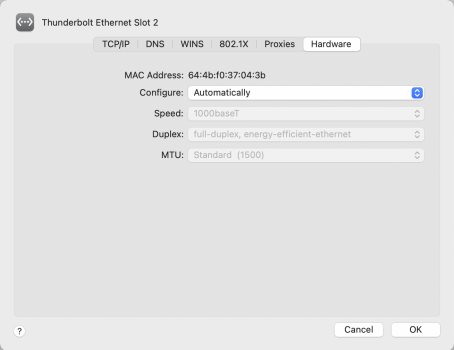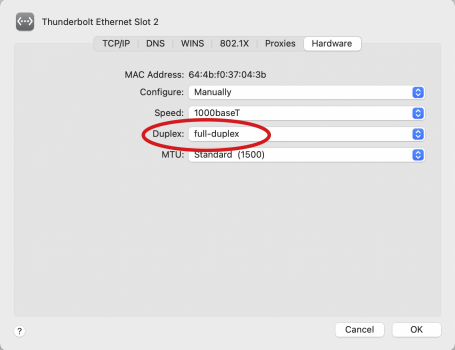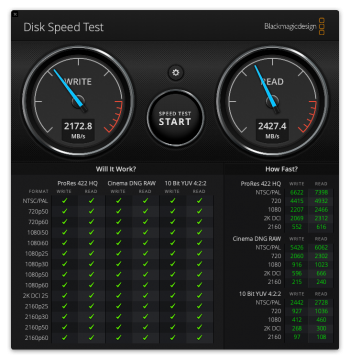I don't actually have a massive problem with that as I have been fine with the current dock's Gigabit Realtek Ethernet and have an 8125B PCIe card in my PC and that's been fine too, although clearly YMMV.
Which dock? I think the TS3+ uses an Intel Gigabit controller.
https://forums.macrumors.com/thread...able-thunderbolt-3-dock.2286171/post-29639488
Looking at the product page I realised that all USB ports are now 10Gb/s. That's a pretty nice upgrade - previously both front USB ports and most of the rear ones were 5Gb/s.
True, but 10 Gbps is also the total maximum for the TS4. The TS3+ had 4 separate USB controllers and could therefore do up to 22 Gbps USB total. The TS4 has either no USB controllers (uses USB tunnelling with USB4 capable hosts) or one USB controller (uses PCIe tunnelling with Thunderbolt 3 hosts). USB tunnelling uses the USB controller of the host instead of the USB controller of the Thunderbolt dock. The USB controller of M1 Macs has lower performance than the USB controller of the Thunderbolt dock.
You can also use both memory card readers at the same time - handy for copying between the two.
If they are the same USB device then you might get half the bandwidth of each memory card.
https://forums.macrumors.com/thread...microsd-real-life-speed.2305126/post-30208491
The SD Card reader might not support UASP.
https://forums.macrumors.com/thread...microsd-real-life-speed.2305126/post-30216710
These things will need to be tested.
The TS4 solves this, though? I can use a 5K and 2.5K display through that single TB4 port?
No. The TS4 has 2 downstream Thunderbolt ports and a DisplayPort port but the Goshen Ridge Thunderbolt controller that it uses only has two DisplayPort Out adapters just like the Thunderbolt 3 controllers (Alpine Ridge and Titan Ridge). Thunderbolt 2 and Thunderbolt 1 controllers only had one DisplayPort Out adapter. An adapter is a part of the Thunderbolt controller - other adapters in the controller include PCIe Up and Down adapters for PCIe tunnelling and USB Up and Down adapters (for USB tunnelling which is new for USB4 and Thunderbolt 4). An LG UltraFine 5K uses both DisplayPort Out adapters so there is none remaining for another display. On the host side, the Thunderbolt host controller has only two DisplayPort In adapters (for getting DisplayPort connections from the GPU). The Thunderbolt controllers in the Blackmagic eGPUs and the Sonnet eGPU Breakaway Puck 5500XT and 5700 have DisplayPort In adapters so they can connect an LG UltraFine 5K to their GPU instead of the host Mac's GPU (M1 Macs don't support eGPUs).
TS4 now the entry page on caldigit.com...
https://www.caldigit.com/
A few notes about their display compatibility chart:
- They show only single 6K60 support for the Intel Thunderbolt 3 Macs or PCs. However, the display must be using HBR2 + DSC, so it should be able to support two of them. Apple doesn't let you connect an XDR using dual HBR3 using a Thunderbolt dock or an optical Thunderbolt cable (unless something has changed?) - the display needs to be connected directly to a Mac using a normal Thunderbolt cable. I don't think PC's support dual HBR3 mode at all (Apple uses a special trick for that mode - it doesn't happen automatically because dual HBR3 can exceed 40 Gbps Thunderbolt limit). Lack of dual 6K60 support is not a problem with their docks - it's a macOS or Windows driver issue or the PC they tested doesn't support DSC or the GPU they tested doesn't have enough performance to do two 6K60 HBR2 + DSC displays.
- Lack of 8K60 support is not a problem with their dock - it's a macOS issue. They should have said it will work when Apple fixes their drivers.
- The USB-C 10Gb/s PC (DP 1.4) is for DisplayPort Alt Mode connection. I suppose it passes up to two lanes of HBR3 (since the other two lanes are for USB 3.x send and receive). It may be enough for 6K60 - the XDR doesn't support single link HBR3 so you need a DisplayPort MST hub to convert two lanes of HBR3 + DSC to four lanes of HB2 + DSC. I'm not sure that works. Normally the XDR uses DSC@12bpp but with only two lanes of HBR3 you need to reduce that to DSC@10bpp. I'm not sure if that would work with the XDR. The only way to get a similar DisplayPort Alt Mode port on a Mac is the MacBook (limited to DisplayPort 1.2) or the USB-C port of a HP Thunderbolt Dock G2 (which is actually provided by a port of an internal DisplayPort 1.4 MST hub). In macOS, there's a way to change the default DSC target bpp but I haven't tried it. Anyway, with the MST hub, dual 4K60 should also be doable (with DSC@12bpp). Remember that macOS doesn't support multiple displays using an MST hub but it should be able to use the DisplayPort conversion features of an MST hub.
I am completely confused -- I don't see how a dock could make my 6K and 4K work over the same single wire running to the Mac M1 Max. I didn't think that was possible, yet that's what their site is claiming. Seems iffy.
Thunderbolt can carry two HBR2 x4 DisplayPort signals (17.28 Gbps each). Or it can carry one HBR3 x4 (25.92 Gbps) connection with one HBR x4 connection (17.28 Gbps).
HBR2 is enough for 4K60 10bpc RGB. Pixel clock = 533.25MHz * 30bpp = 16 Gbps.
HBR2 is also enough for 6K60 12bpc RGB (using DSC@12bpp). Pixel clock = 1286MHz * 12bpp = 15.4 Gbps.
6K60 uses less bandwidth than 4K60!
Without DSC, two HBR3 x4 connections is required (using Apple's special dual HBR3 trick for Thunderbolt). 648.91MHz * 2 * 30bpp = 38.9 Gbps which leaves no room for a third DisplayPort connection and very little bandwidth for USB (at least for writes - I haven't seen anyone USB read speed of a USB NVMe drive connected to an XDR's USB 3.0 ports).





